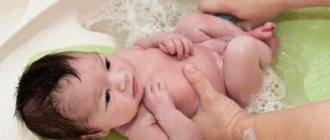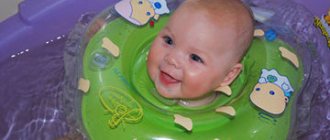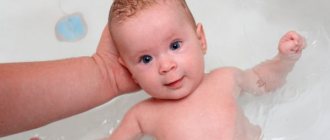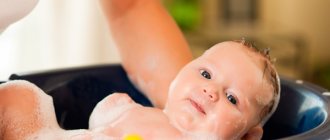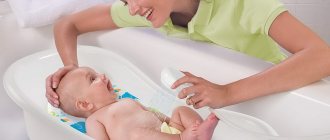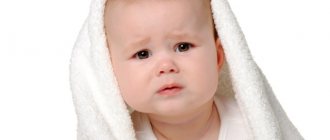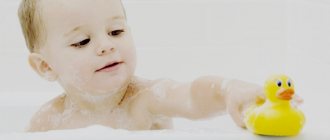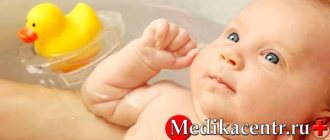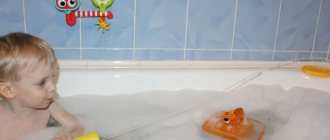Do you know how to turn bathing your baby from a troublesome procedure into a fun and interesting activity? As a rule, many parents prepare for their baby’s first immersion in water with joyful excitement, but end up spending a lot of effort holding the baby over the bathtub in a very uncomfortable position. The only thing that moms and dads feel at this moment is the desire to complete the procedure as soon as possible. Fortunately, there is now quite a large selection of useful bathing accessories that can give mom, dad and baby an easy and joyful time in the bath. And one of them is a slide for bathing newborns. A bath slide, also called a sun lounger or chaise longue, is an excellent device that holds a child in the bath and allows you to relieve the mother’s back, which is tired during the day.
How long does it take to swim on the slide?
This question may interest many parents. It turns out that this device is mainly used by children in the first months of life. It is important that the toddler’s umbilical wound has time to heal. However, if you bathe your baby not in an adult bath, but in his own, then the use of a slide is allowed from the first months of life. Actually, the age limit indicated on such a device is “0+”. Using a slide for a baby who has already learned to sit is quite inconvenient. The little one can now hold his head above the surface of the water; now he will be interested in playing with toys designed for water procedures, rather than lying on a slide.
We didn't use the slide. But my friend Tanechka bought a slide immediately complete with a classic bath. The seller advised her so, but she didn’t regret it for a second. Tanechka’s child was born when my son was already six months old. I didn't even know there were slides. When I saw how she bathed her two-month-old baby, she was pleasantly surprised and regretted that she had not known about such a device before. In fact, it would make my family's life a lot easier. After all, in the first months of the baby’s life, the grandmother and dad were involved in the bathing process. One person could not do this. And we had to adjust the bathing process so that there were at least two adults at home.
Is the slide suitable for an adult bath?
Experts recommend using slides only in baby baths, and here's why:
- During the bathing process, parents have to bend low to bathe the baby. After such procedures, lower back pain often occurs.
- Babies are often bathed in potassium permanganate. It can stain the white enamel of your bathtub.
- You need to fill the bath with more water. A children's accessory is much more economical in this regard.
- It is easier to keep a baby bath perfectly clean: it is easy to wash.
If you nevertheless decide to bathe your baby in a regular bath, then forget about any structures and stands that would raise the slide to the height you need. This poses a hidden danger: a child may fall and hit a metal surface.
Variety of species
Before purchasing a bath slide, you need to familiarize yourself with what types exist, and also find out what you need to follow when choosing a suitable product.
Criterias of choice:
- First of all, make sure that the mount is made of sufficiently durable material.
- When purchasing a slide, you need to take into account that it may not be suitable for a bathtub with a rounded bottom. It is often important to have a flat surface to install such a device.
- Pay attention to the presence of an anti-slip surface on the slide or the presence of ledges that will prevent the risk of your baby slipping under the water.
Now let's take a look at the main types of swimming slides:
- Anatomical plastic slide. This slide is suitable for any bath. Often equipped with special suction cups for secure fixation. This type of slide is easier to clean. Some models may have height regulation, and also have a thermal sticker that will react to the temperature indicator and will be able to promptly report a decrease in the optimal degree. However, there is also a minus - the slide is quite hard, so it is necessary to lay a diaper.
When choosing a slide of this type, consider the following:
- choose a device made of high-quality material and without a pungent odor;
- make sure that the design of the product is stable;
- give preference to slides with rubber suction cups for reliable fixation;
- It is better to choose a slide with an anti-slip mat.
- Fabric slide (hammock). Fixation occurs with the help of hooks on the sides of the bathroom.
Positive properties include:
- the presence of natural material that comes into contact with the baby’s skin;
- easy to clean, dries quickly;
- is small-sized, especially when folded;
- significantly cheaper than its analogues.
The disadvantages include:
- Foam slide. It is placed on the bottom of the bathtub. It has a special recess for the baby's body. There is a special obstacle between the legs that prevents the baby from sliding into the water.
The advantages of this device include:
- rapid absorption of warm water, which allows you to keep the child in a warm environment for a long time;
- quite soft and comfortable material;
- Can be used both in an adult bath and in a children's bath.
The disadvantages of this device include:
- short service life;
- the ability to retain particles of dirt and possible bacteria;
- long cleaning and drying process.
In addition to these options, there is a slide designed for older children and can be used up to a year old. This is a slide-chair. Suitable for a baby who has learned to sit confidently. Fastening occurs due to special suction cups. Some models are equipped with a 360 degree rotation function.
You see that when using any slide there are both disadvantages and advantages. Therefore, it’s up to you, choose the device that will be most convenient for your little one.
How is it convenient?
While bathing, you need to simultaneously hold the baby, lather, wash off the foam with water and make sure that he does not slip out of your hands. It is inconvenient for one person to do this. A slide in the bath allows you not to worry about the safety of the baby and saves the energy of the adult. It helps to prolong water procedures if the baby likes to splash and soak in warm water.
Some models are suitable for an adult bath or can be used for bathing a baby in the sink. They can be used from a very early age; it is important to choose a slide that is suitable for the child and practical to care for.
How to bathe a newborn for the first time with a slide
If you have already decided that it is time to buy a slide for bathing your recently born baby, you need to know what rules should be followed when using it:
- Before first use, the fabric slide must be washed and the plastic slide must be treated with a soda solution.
- First you should rinse the slide with water.
- Make sure all necessary bathing items are within reach. Never leave your child on the slide unattended.
- Make sure that the slide is firmly fixed.
- Fill the bathtub with as much water as needed so that the slide is half covered.
- Re-check that the slide is properly secured.
- If you have a plastic slide, place a diaper on its bottom or a special mattress.
- Gently lower your baby into the water.
- It is important that the water does not exceed the level of the toddler’s neck.
- After bathing, take care of your care. Rinse the slide and set it to dry.
Water temperature and swimming time
When bathing a baby for the first time at home, the duration of the procedure should not exceed 5 minutes. Gradually the time can be increased to 10-15 minutes. You can bathe a six-month-old child for 25-30 minutes, but it is important to ensure that the water temperature does not drop and the baby does not have time to freeze.
Before starting the procedure, it is necessary to measure the temperature of the water poured into the bath using a special thermometer. The recommended range is 34-37°C. After a few weeks, you can begin to gradually reduce the water temperature by 1 degree, bringing it to 30-31°C.
On a note!
Experienced mothers measure the temperature of the water using their elbow dipped into the liquid. In this case, the feeling should be neutral.
Recommendations
- If your little one already knows how to sit up on his own, install in the bathroom, in addition to the slide, a special rug that, in case of emergency, will protect the baby from slipping.
- For newborns, it is always better to put a diaper on, regardless of the type of slide, because in such little ones the process of thermal regulation is still disrupted.
- When using for the first time, it is better to take very little water, let the baby get used to the slide and learn to be in this position during the bathing process.
- Remember to wash and dry your fabric slides thoroughly. This must be done to prevent the risk of possible rashes.
- It is very important to clean and dry foam slides. They can become a breeding ground for bacteria.
- Make sure that the selected slide matches the weight and height of the baby; do not forget that children grow.
We recommend reading:
- How to bathe a child with a circle on his neck;
- How to bathe a child in a large bathtub;
- Rules for bathing a newborn.
Take care of purchasing a bathing slide - this will make the bathing process much easier for mom and baby. When making a purchase, make sure you make the right choice, carefully study what model options are available, what functions the slide is equipped with, and what quality of material this product has. Let the process of swimming with a slide be a joy for you and make this procedure much easier.
From what age can it be used?
It is very important to find the answer to the question: “A slide for bathing newborns: at what age is it needed?” Experts assure that almost all models are designed for babies from the first days of life. Accessories are marked as follows: “0+”.
In turn, pediatricians do not recommend bathing babies until their umbilical cord falls off. In this case, the risks of infection and suppuration are minimized. As a rule, 7-8 days after birth, the umbilical cord dries out and falls off on its own.
Cosmetics
In the first months of life, many doctors do not recommend using soaps and gels when bathing the baby. The reason for this is a valuable substance that envelops the baby’s skin before birth and several months after. It finally disappears after the child has fully adapted to the outside world, when the epidermis becomes thicker. Since infants practically do not get dirty, they do not need additional hygiene products. It is better to add a little manganese or decoctions of string and chamomile to the water. You can find an alternative - natural cosmetics that do not contain allergens, dyes, or flavors.
Plastic model
It costs an order of magnitude more, but parents often prefer it because of its ease of use. It is suitable for any type of bath; many options have special suction cups that secure the product.
It is easy to wash and can be used for games not only during bathing. For children who can sit, there are special seat slides. Until this time, they are not recommended to be used so that the baby does not have a curvature of the spine. When choosing, you need to consider:
- Quality. The plastic must be strong and not have a strong toxic odor;
- Design – it is better to choose a stable one;
- The presence of suction cups or rubberized plates that prevent slipping;
- The surface should be comfortable, with recesses and stops to support the baby;
- The presence of an anti-slip mat to hold the child. It provides additional security.
The disadvantage is its hardness compared to other models, the need to put a diaper on it for the baby’s comfort.
Some manufacturers offer the product with a thermal sticker. It shows the degree of heating of the water, allows you to notice in time that it has cooled down and stop the procedure. If a child does not like to swim for a long time, then it is not worth overpaying for such a function.
How to choose a bath
A wide range of baby bathtubs allows parents to choose the most convenient model. The most popular models of devices are:
- Classic. It is usually oval in shape and can be installed not only in a large family bathtub, but also on a table or chair. Traditional models differ in size, design and color scheme. The only downside to bathing a child in such a bath is the need for an assistant until the mother gets the hang of doing it herself;
- Anatomical. A classic oval-shaped bathtub with special convexities on the bottom that follow the anatomical contours of the child’s body. The convex bottom of the bathtub prevents the baby from slipping and helps keep the body in one position. Suitable for very young children. It is impossible to swim in such a bathtub, and it will be uncomfortable for a slightly older baby to bathe while sitting;
- Inflatable. Useful for travel or as a pool. At home, inflating it every day is a troublesome task, but if there is no free space for storing a baby bath, then an inflatable container will be an excellent solution. You don’t have to worry about the baby’s safety, since spontaneous release of air from the inflatable product is prevented thanks to the ring structure and safe valves;
- Installed on the edge of the bathtub. These baths have a small capacity and are intended for very young children;
- Built into the changing table. This is the most modern model, which has a water drain and wheels.
Classic bath for newborns
Anatomically shaped bathtub for bathing a baby
Inflatable baby bath
Bathtub for newborns, installed on the edge of the bathtub
Bath tub built into the changing table
When choosing a baby bath, size is important; the longer you plan to bathe your newborn in a small bath, the larger it should be. Pay attention to the quality of the material, durability and hygiene (easy to clean). To figure out which bathtub is best for bathing newborns, we recommend that you read our tips.
DIY swimming slide
Here we are talking about making a fabric slide for swimming. Young parents can make a hammock slide that will be attached to the edges of a bathtub or bathtub. This is especially true if your bathtub is of non-standard size or shape. In this case, it is worthwhile to provide a safe hypoallergenic material, which at the same time should be durable and at the same time pleasant to the touch. After all, this fabric will have to be in direct contact with the baby’s body. Reliable fastenings are an integral part of a swimming slide.
But it’s hardly worth experimenting with making a slide from scrap materials such as plastic, wood, etc. It is difficult to take into account all the anatomical features of the baby’s body, unless of course you are a professional physician. And secondly, swimming slides have a relatively low cost, and their service life allows you to raise more than one child.
Slide for bathing newborns: reviews from parents
- Lilya. 22 years old. Rostov-on-Don. “Before our baby’s belly button shrank, we didn’t really think about how we would bathe her. We bought, of course, a bathtub, and then, on the advice of a friend, we bought a pile of hammocks, and I must say they made the right decision, and the baby was comfortable in it and it became much easier for me to bathe her!”
- Kate. 27 years. Moscow. “We didn’t buy a slide for our firstborn, but when our second baby was born, we decided to try this miracle of civilization and bought a foam rubber slide for swimming. I can’t say that the process of bathing a baby on a foam slide is particularly different from the process of bathing in a diaper. Well, it’s just like there’s no need to lay the bedding on the slide in the bathroom and that’s it, and it’s the same thing.”
- Vika. 23 years old. Saint Petersburg. “After reading various tips on the Internet, we bought a Dolphin swimming slide for our baby, but it was a waste of time! We used it once for two or three minutes, which was enough to understand that this slide is not even needed for nothing.”
- Dina. 20 years of Elektrostal. “I’m a young mother, my first child, and it’s clear that the thought of bathing my baby made me panic, but when we bought a pile of hammocks, I was practically reborn. Swimming with such a device is really fun and safe!”
- Olesya. 22 years old. Ufa. “Our Anatomical swimming slide is just super, I just really see that, firstly, my daughter is comfortable in it and secondly, she feels safe and free. If I still have a baby, bathing only with a slide, not any diapers!”
- Olya. 23 years old. Moscow. “My older sister gave birth before me and therefore, of course, she came to give me QI for my first bath, and I must say she was extremely surprised that we did not buy a slide for bathing a newborn. Her husband quickly went and brought us their Dolphin slide, and the next day we bought one for ourselves. The baby is comfortable, I am calm and both are extremely comfortable!”
Bathing process
After being discharged from the maternity hospital, a young mother does not know how to properly bathe her first tiny child. Lack of experience should not be scary; these tips will help you do everything right:
- The first bathing (usually on the second day after discharge) with a non-healed navel is carried out only with boiled water and potassium permanganate, then you can use “raw” water. You should be careful with potassium permanganate, the water should be slightly pink, otherwise it will dry out the baby’s skin greatly;
- The optimal water temperature is 36.6-36.8°C, but if you need to cheer up the child, you can make it cooler, or warmer to calm it down. It is not necessary to have a thermometer to determine the temperature of the water; you can test it with your elbow. If you put your elbow in a bath of water and did not feel any cold or heat, then the water temperature is correct and you can start bathing your baby;
- To avoid catching a child’s cold, the air temperature in the bathing room should be 22–24°C. It is advisable to leave the bathroom door open, but drafts should not be allowed, for example, closing the hood or window;
- Immersion of a child in water should be gradual, starting from the legs; sudden movements can frighten him and cause a persistent dislike for water procedures;
- After bathing, you should not rub your baby’s delicate skin with a towel; just blot the droplets of water with a diaper, paying special attention to the folds.
If there is not enough space in the bathroom for a hygienic procedure, after bathing you can take the baby wrapped in a towel into the kitchen or room, where you can blot his skin with a towel. The main thing is that the room is warm and there are no drafts.
You should not bathe the whole newborn too often. Experts recommend bathing a newborn baby 2-3 times a week so as not to deprive the skin of its natural protective layer. But the face, hands, and private parts must be cleaned daily.
Every mother worries that water will get into the baby’s ears and he will catch some disease, for example, otitis media. There is nothing to be afraid of, otitis media is caused by an infection that comes from the nasopharynx, and not from tap water, especially if it is boiled.
Plastic base with fabric surface
This design is quite strong, but softer; the material adapts to the baby’s body; there is no need to lay a diaper for his comfort. Unlike a foam slide, it is easier to care for, the fabric can be removed and is easier to wash and dry. There are two options:
- A straight slide, not very comfortable due to the baby slipping;
- The lounger, similar to a chair, secures the child due to the lower raised part. Most models fold for easy storage and transportation.
Preference should be given to special anatomical slides, the fabric of which has recesses that repeat the silhouette of the baby. They hold it more securely, preventing it from slipping.
